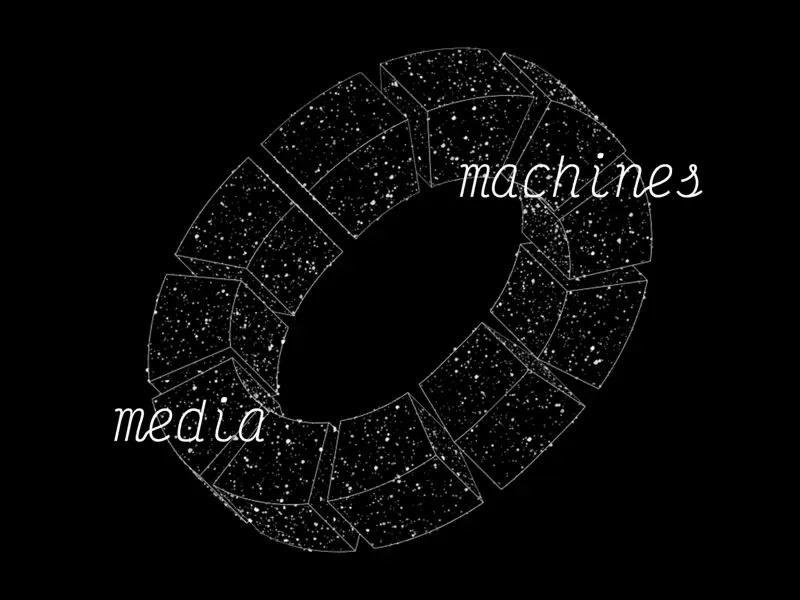MEDIA AND MACHINES.
The operating system of our era — and why every empire will be half-media, half-machine.
Every era gets the duality it deserves — war and peace, faith and reason, labor and capital. I've been circling this question: what’s ours?
If every era is defined by a binary, ours is shaped by the fusion of two: media and machines — once distinct forces, now collapsed into a single living system that governs what gets built, what breaks through, and what defines our reality.
What began as separate domains — machines mastering logic, media monopolizing attention — has merged into a Möbius strip of mutual reinforcement, where media creates machines creates media. The media-machine singularity is the operating system of our age.
The birth of the superorganism
The revelation came with social networks — those first native superorganisms of the media-machine fusion. Facebook, YouTube, TikTok weren’t just social media, they were self-replicating loops where every post was both content and infrastructure — where the machine shaped the media that grew the machine.
Social networks recast the entire blueprint of creation and culture. These platforms became our new cities, economies, and gods (and it’s turned out as spectacular and scary as it sounds.) Now, what we once called the “attention economy” has swallowed the traditional one.
Careers rise and fall on algorithmic affinity. Markets move at the speed of trending topics, memes, and ever-fickler sentiment. We now inhabit the world they made, where every interaction is both input and output for the superorganism.
The medium is the message is the machine
If social networks were the prototype, AI hits full send on the hypothesis. These large language models are born from ingested media we spent the last decades creating, and exist to generate more: the Ouroboros of code and culture. Marshall McLuhan was ever prescient:
In the age of language models, the medium is the message — is the machine.
Natural language is now both interface and infrastructure. The old divisions vanish: to build is to write is to build again. Computational force and cultural resonance emerge from the same source. This compound creature thrives on reciprocal nourishment: feed its media half and its machine capabilities grow; starve its machine needs and its cultural influence withers.
What’s coming will make social networks look quaint: tools become networks, function becomes feeds, solo becomes social — all with frightening intelligence. We move from ephemeral to memory, prompts to personality, feeds to worlds — software to sentience. The machine no longer mediates reality; it becomes it.
We build AI to elevate humanity — to cure, decode, transcend. Yet like all mortal creations, it bends toward what's rewarded: commerce, companionship, cachet. We call this 'progress'— but is it acceleration toward greater civilization, or just a new Facebook? Is OpenAI just another FAANG-shaped god for the ‘new’ era? The answer is either yes, or yes and.
Reality engineering
We’re no longer designing just products or platforms or interfaces, but cognitive environments — architectures of attention that shape what people see, feel, and believe. Every engineering decision is now a cultural act. Every narrative choice carries technical consequence. The stakes have risen beyond business or tech to configuring the operating system of human attention itself.
Baudrillard’s hyperreality — where simulations become more real than reality — was a warning. This is its seamless execution: a world where the map not only precedes the territory but engineers it in real time.
Eventually, everything visible will be subsumed by the media-machine complex. The only remaining “alpha” will be what resists digitization, what can’t be priced in: off-grid experience, instinct, volatility — the unmodelable edge. A jazz improvisation that dies in the air, the silence between old friends who need no words, a collection of PDFs that hold humanity’s greatest secrets.
But even that is fragile. The irony is that as soon as anything is observed or acknowledged, it’ll be modeled. It’s the inverse of the “tree falls in forest” parable — not whether it happened unseen, but whether it still matters once seen by all. To escape total immersion is to demand either defiance or ownership. The final human edge is in controlling the machine or keeping your distance — in how many steps ahead, or how many steps removed, you are at any given moment.1
The alchemy of modern attention
The media-machine fusion creates the great paradox: systems that grant us godlike leverage now drown us in algorithmic slop.2 The dead internet theory earns its resonance. The retreat to trust commences. Legacy media fractures more; personality cults rise. Vital stories migrate to blogs, mini-sites, Substack, and YouTube (for now). The most resonant storytellers are subscribed to, not employed.
But are we still creating for people — or for the machine that feeds them? (At some point, Substack gave me an option to block ChatGPT and the like from “training” on my essays, so I did. At what point does that become foolish of me?)
Even capital has surrendered. Venture funds all but operate like media companies, and increasingly invest in them. When founders, athletes, and kings are jostling for the same mic, you witness the new reality: in the attention economy, even fame, money, and power need marketing. A product without a myth, a funding round without a podcast tour: both feel incomplete. Manifestos and TBPN are the new minimum. There’s an urgency to capture attention now, almost as if it’s the last chance to “lock-in.”
The new game is barbell-shaped: it’s high-gloss performance for audience capture or deep craft as slow rebellion, and little in between (unless you already have cred, in which case slick-indie sells too). Attention first, product second, if at all. But building still matters. It just takes more now.
The new maker’s manifesto
YC’s famed doctrine, "make something people want" and its cult of the technical founder is timeless, yet could now read as quaint. Today, the making and the wanting must be engineered simultaneously. That too, not just the wanting of ‘users’ you talk to directly, but of the machines that will inevitably talk to them on your behalf too. The most ambitious and strategic ones will try their best at both.
Every organization will now operate as half-media, half-machine. Every media company will have a head of machines and every machine company will have a head of media. Call it the media-machine singularity of business, the hybrid imperative.
Tactically, let’s call it The Anu Principle … Anu’s Theory, Anu’s Law (critical apostrophe).
“Attention guys” are the new engineers — the new unicorn hires — while engineers have become the skilled tradesmen. Idea guys, however emboldened they may now be, are still only as valuable as their ability to finish a product (not just start it with a vibe-coded prototype), and their ability to get distribution.
This singularity requires new organizational DNA: not just leaner teams or AI-agents-as-staff, but a fundamental reimagining of what makes good media and good machines — in function, form, and faith — and who’s best fit to build them.34
The builder’s role has evolved — no longer just a technical architect, but a polymath weaving machines and media into civilization-shaping sculptures. Brilliant engineers now need storytellers and psychological savants.
The renaissance mind returns not as dilettante but as armed philosopher, wielding systems fluency and cultural intelligence equally. The requisites: IQ, EQ, agency, taste — and a will to brute-force your way into the frame. The media-machine singularity will give us some of the most iconic, powerful, hybrid artists we’ve ever seen.
The great work of our time
McLuhan’s axiom returns: “first we shape our tools, then our tools shape us” — but faster now, with the media-machine superorganism rewiring us at scale. These machines optimize for transmission, not truth. They generate coherence, real or not, and wrap it in messages convincing enough to make you nod along.
This raises three unavoidable crucibles:
Infinite production demands infinite care — every algorithm’s output becomes someone’s input, every generated phrase someone’s truth.
Transmission and virality without virtue isn’t progress but social and cultural vandalism, burning through meaning to fuel empty engagement.
Our ultimate test isn’t in technical mastery or narrative flair, but in judgment — the courage to feed the machine something better than its own reflex.5
The questions shift from what can scale to what should. This is the great work of our time: not just building what spreads, but what matters. Not just making things people want, but cultivating the desire for what’s worth wanting.
If media and machines have fused into one great engine of scale, what stands opposite it? Man’s search for meaning. But in an age of accelerating extremes, even meaning must market itself to remain relevant. We like to think it waits patiently in our private lives — but I suspect that’s wishful thinking. Meaning too must earn its keep.6
Whether you build products, tell stories, direct capital, or curate culture, you are now both architect and artifact of this age. The media-machine complex will metabolize and manifest whatever we feed it, then spit it back out for you to binge. So feed it carefully.
If you enjoyed this essay, consider sharing it with a friend or community that might enjoy it too. I welcome reactions, reflections, and thought-provoking questions!
Related essays: The Aesthetic Is The Art Now, Taste Is Eating Silicon Valley, Man’s Pursuit of Greatness Is the Pursuit of a Great Film, Rise of the Software Creator.
Not everything has folded into the loop. Open source models promise transparency. Web3 yearns for decentralization. Wikipedia long resisted AI. IRL is a temporary haven. Fiction fights back: There Is No Antimemetics Division is a fantasy of containment in an age of contagion. The fusion is potent but not absolute. Some edges will hold with herculean effort.
The convergence rages on in every frontier. Apple spends billions crafting prestige television. Hollywood scrambles to metabolize AI. Politics flails as it attempts to adapt.
People have said “builders must be storytellers” or a similar refrain for a while, but usually tactically: for fundraising, hiring, growth. I don’t mean marketing as a wrapper, but media as core and membrane that makes the machine accessible, legible, desirable.
Yet, the ultimate power may belong to those who build nothing tangible at all — the new mythmakers who define what deserves to exist and which futures we realize.
This is not only true at the model level but the individual level. Soon there will be such a thing as unhealthy and healthy prompting, a kind of psychological score for queries.
The safeguards seem to be missing: transparency in how machines shape belief, intentionality in what media amplifies, spaces where fusion is forbidden (libraries, courts, temples). If we engineer reality now, we have to engineer accountability too.
Image sources: Header image. Share image (modified).




Another classic. Wouldn't remove a single word.
In terms of social organizing, I believe we are bifurcating into Hyper-URL (Slop Economy) and Hyper-IRL ("Unmodelable Edge").
• Hyper-URL: doomscrolling, AI GFs/BFs, Twitch/YouTube/IG/TikTok Streaming, Discord voice channels for memecoin trading and gaming
• Hyper-IRL: run clubs, speed dating / singles clubs, Othership / Coffee and Chill, DJ pop-ups at random locations, meditation/psychedelic retreats
Hyper-URL and Hyper-URL may also converge now:
• New York Parks, especially Washington Square Park
- https://x.com/coldhealing/status/1915398322161943003,
- https://x.com/coldhealing/status/1915053939340575177
- https://nyunews.com/news/2023/08/04/kai-cenat-union-square-riot/
• Balaji's Network School / State
• Bryan Johnson's Don't Die Summits
What a thought provoking piece. I wonder about consequences the media-machine superorganism has on human capabilities, specially memory and imagination.